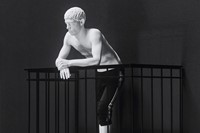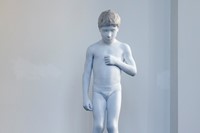This article is taken from the Spring/Summer 2022 issue of AnOther Magazine:
The work of artists Elmgreen & Dragset may at first glance seem cold, dominated by large, cavernous spaces or impenetrable monuments and a predominantly minimal colour palette of black, white, gold and grey – with the notable exception of a piercing swimming-pool blue. But spanning performance, architecture, public art, figurative sculpture and installation, each piece is connected by a sense of the thrumming humanity of societal living. Take Cruising Pavilion/Powerless Structures, Fig. 55 (1998) – a corrugated white cube of a space installed in Aarhus, Denmark, in a park known for late-night hook-ups. Housing a cherry wood bench and with glory holes in its interior walls, it quickly became a diurnal stopping space for dog walkers and passers-by. Explorations of conformity, sexuality, desire, power and powerlessness, inequality and community are ever present: by inviting the viewer in they create a social structure all their own.
Having met at the Copenhagen nightclub After Dark in 1994, Danish poet Michael Elmgreen and Norwegian theatre graduate Ingar Dragset began working together and dating. The end of their romantic relationship in 2004 coincided, Dragset has said, “with us daring to be more personal in our art”. They now have nearly three decades of world-famous works under their belt, including Short Cut (2003), a humble Fiat Uno pulling a retro caravan that had seemingly crashed up through the ground of the Galleria Vittorio Emanuele shopping mall in Milan. Then there’s The Collectors (2009), a joint curation of the Danish and Nordic Pavilions at that year’s Venice Biennale (the luxurious house and belongings of a mysterious collector, Mr B, who incidentally was floating, dead, in his swimming pool out front); Van Gogh’s Ear (2016), another cyan pool, this time turned on its side and placed at the foot of New York’s Rockefeller Centre; and Statue of Liberty (2019), an unusable ATM installed in a slice of the Berlin Wall at Hamburger Bahnhof, Berlin’s museum of contemporary art. Form, space and composition are key to these works – but always in relation to their environment and the comings and goings of the people who choose to visit them. And those people are, more often than not, the beating heart of the Elmgreen & Dragset experience. Useless Bodies?, a vast exhibition of seen and unseen works opening at Fondazione Prada this spring, brings this increasingly powerful mindset to a head.
This isn’t the first time Elmgreen & Dragset and Prada have met. In 2005 the artists installed one of their most well-known works: a never-open replica Prada boutique on the desert-lined Route 90 in Jeff Davis County, Texas, 36 miles northwest of the art-tourism destination Marfa. A piece of pop architectural land art belonging to a series they refer to as “denials”, the store, stocked with six handbags and 14 right-footed boots, looked at fake opportunities – possibilities that aren’t really possibilities, “those that make you feel excluded and frustrated”, as they told art writer Linda Yablonsky in their eponymous 2019 Phaidon monograph. Importantly, the piece was self-initiated, but Miuccia Prada gave them permission to realise it – “We needed to have the precise colour code of their mint green shelves and the logo,” Elmgreen says – and what’s more, she liked it, and sent its creators a note to say so.
Almost 17 years later and Elmgreen & Dragset have been given carte blanche to fill 3,000 square metres of the Fondazione Prada in Milan – marking one of the venue’s most ambitious thematic investigations to date. Occupying four distinct spaces – the Cisterna, two floors of the Podium, the Nord Gallery – and the main courtyard of the Rem Koolhaas-designed grounds, this is the artists’ take on the condition of the body in a digital-centric post-industrial age, and the increasing superfluousness of physicality that entails. “Our bodies are no longer the main agents of our existence,” the artists say. “They don’t generate value in our societies’ advanced production methods as they did in the industrial era. One could claim our physical selves have even become more of an obstacle than an advantage.” Here, photographer Marton Perlaki captures those bodies – both final works and studies – in the artists’ Berlin studio; while curator, critic, art historian and previous collaborator Hans Ulrich Obrist discusses with them the future of the body, art and experientialism.
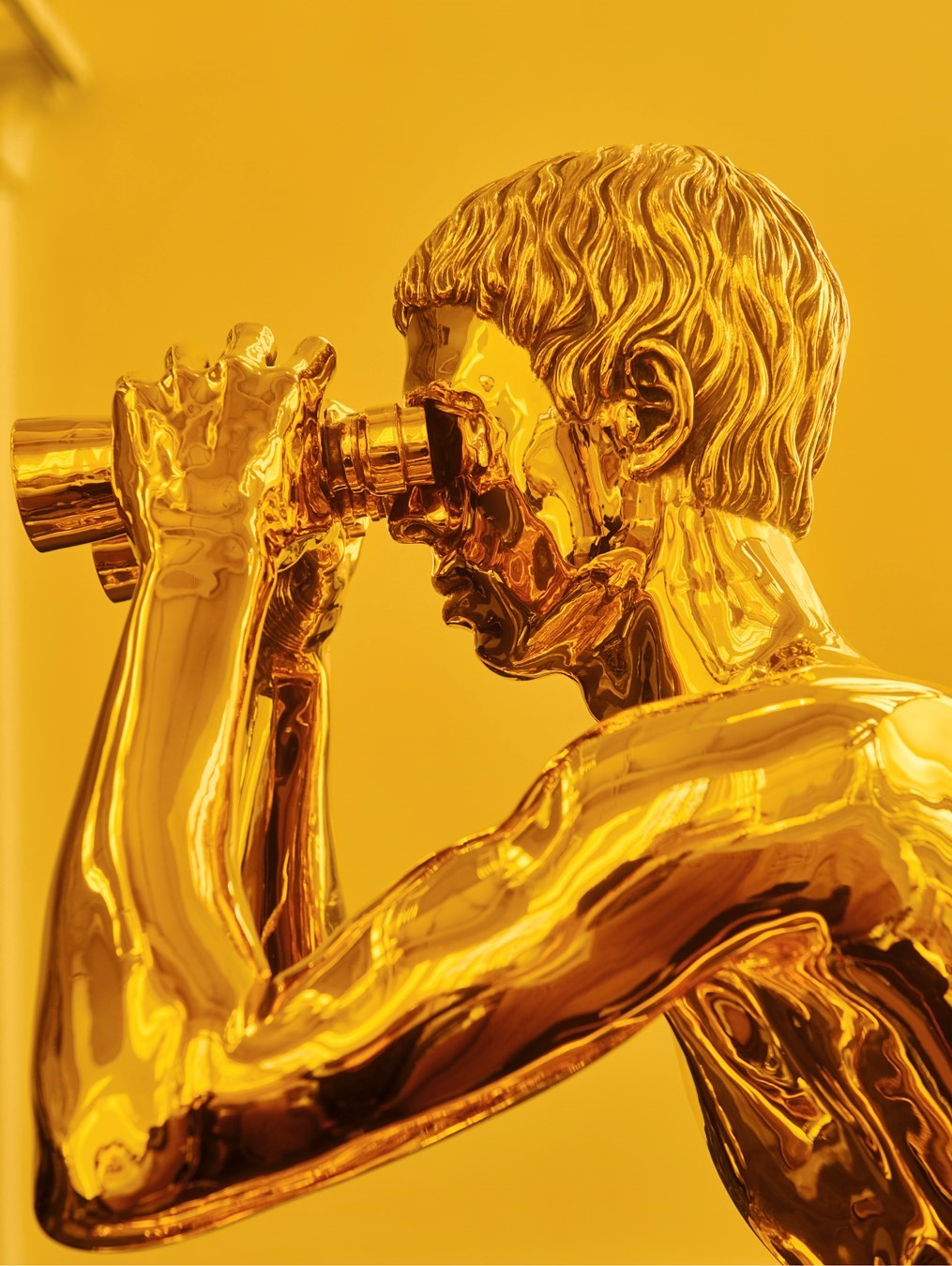
Hans Ulrich Obrist: The entire world has entered a post-planning age.
Michael Elmgreen: I remember the first time we did a performance in Mexico City and it wasn’t ready on the opening day. As Scandinavians, who panic if the post is 30 seconds late, we were completely freaked out. However they said, “Well, come back tomorrow,” and everyone just came back the next day and no harm was done. It was perfect. Recently I’ve spoken with some friends from other places in the world about the difficulties of planning now and they replied, “Welcome to our world. It was never the case for us that we could plan a year ahead. We didn’t even know if the currency would still be there or if the political system would have changed completely.” A bit of uncertainty can actually be liberating in the end.
HUO: Exactly. However, in this post-planning condition, certain things are still being planned – your Fondazione Prada exhibition, for example, which is going to open at the end of March, and will last quite long, until late August. The duration of exhibitions has increased almost everywhere over the past two years – that longue durée approach is more sustainable. That whole rhythm of changing shows every six to eight weeks is shifting. I remember in the 1990s when I went to New York, Dia’s shows were there for six months and now – in this, shall we call it, re-Covid situation – almost all the schedules are like Dia’s. Roman Krznaric wrote a really urgent book, The Good Ancestor, and it’s about this idea that we need to liberate society from this short-termism because it’s an environmental disaster, these deadlines and velocity are just not sustainable. We need to think about longer duration. That can be legacy projects like the Sagrada Familia, a project on which one works for a long, long time. But then there are exhibitions that become gardens – like with Precious Okoyomon – there are artists like Otobong Nkanga who are more interested in farming, slower rhythms. So your show is going to last six months – but have you experienced any other new notions of long duration?
ME: This show has been planned since 2017. So I think we are some of the longest employees at Fondazione Prada. In recent years we have learnt to appreciate a long process, to get to know each other and, when working together on a collaboration like artist-curator-institution, to get a real sense of each other – not just fly in, fly out. We’re all starting to appreciate slowness more and more – it is so different when you can prepare for a long time. In this case, Covid arrived in the middle of the planning and we had the chance to adjust our initial ideas as the exhibition will, of course, be read in a different light now that the world has changed so radically.
HUO: And if we think about longer duration, exhibitions are just one possibility. In the 1990s, when we first met, there was such a big focus on exhibitions. It’s interesting that your work over the past 20 years has gone beyond the exhibition space. Prada Marfa, for example – the hyperrealist boutique, which is still there in the desert, 17 years later. Then there’s Memorial to Homosexuals Persecuted Under the National Socialist Regime [2008], your very important public artwork in Berlin. I was watching Brilliant Ideas again, the Bloomberg documentary about you – it was very moving to see these visitors at your Berlin monument talking about their experience. It reaches out to people who would never go to a museum because there isn’t a door to it. Art can happen where people expect it the least. Then there’s Van Gogh’s Ear, the upturned swimming pool you installed at the Rockefeller Centre [in New York]. What is the importance of public art for you? Of taking art to the people?
Ingar Dragset: Two of the pieces you have mentioned are examples of art in public space that also transform over time. If you take Berlin’s Memorial to Homosexuals Persecuted Under the National Socialist Regime, for instance, we opened up the minimal square form of the memorial as a sort of platform. Since its inauguration there have been three different video works shown inside it – at the moment it’s a film by Yael Bartana – which means it’s always possible to renew the perception of the monument, the discussions around it and what memorial culture should be. We have also seen a drastic change in concepts of identity since it was installed in 2008, which the changing films reflect. Then there’s Van Gogh’s Ear [2016], which was produced in Germany, exhibited in New York in front of the Rockefeller Centre, and then acquired by K11 in Hong Kong. And it’s since been shown in various Chinese cities. So the piece is travelling and getting a different meaning every time it’s shown. Interestingly, right now, it’s showing in Wuhan, where the current pandemic started.
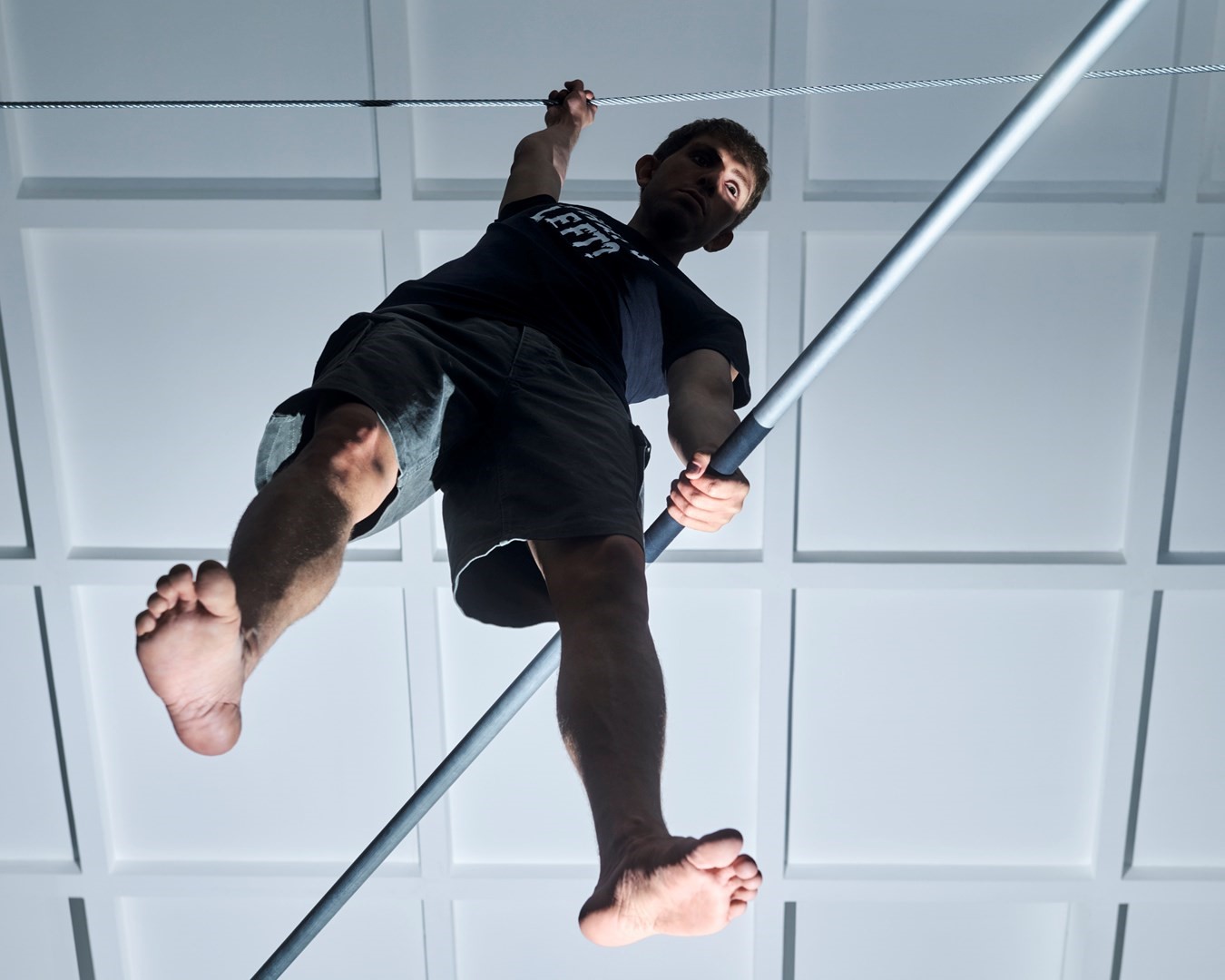
ME: It’s interesting that even permanent pieces can change over time, they don’t need to be so static. We have created one of the very few permanent performance pieces as a public art project, It’s Never Too Late to Say Sorry [2011-]. It is in Rotterdam and consists of a glass vitrine containing a bullhorn megaphone where, for the first two years, a guy would come every day at noon and shout through it, “It’s never too late to say sorry!” Now the same person does it every Wednesday, but it’s been there for so long that it has become an integrated part of the city’s life, almost like a clock tower. When the performer shouts his message, people know it is midday. Yet it’s always a new situation – every time, he arrives in a different way and he’s older with each year. You can have a permanent piece that is repetitive and is present over a long time but it can still renew itself and have a new life.
ID: And that piece has also been activated in other places in the world.
HUO: My favourite question is about unrealised projects – we know a great deal about architects’ unrealised projects because they publish them as part of competition entries. But we know very little about artists’ unrealised projects – do you have any unrealised public art projects or commissions, or lost competitions that were censored?
ME: Recently we worked on a project with a great artistic committee until the very last minute, when the administration of that institution decided that they didn’t want it because of logistical reasons – money or whatever. It was a work meant for a new hospital that claimed that it wanted to be a hospital in a completely different way, a place where people would like to go even if they were not sick. And we thought, “That sounds great.” We proposed to have an extensive art library and a small kunsthalle inside the hospital, so that patients and visitors could go to the library and to the exhibition space – the hospital would not only be about the rehabilitation of someone’s health. Imagine getting patients interested in art while they were hospitalised.
“Home has a different function today – because of our screens. Our homes have been reduced to the backdrop for Zoom meetings instead of the frame for dinner parties” – Michael Elmgreen
HUO: Your Fondazione Prada exhibition is a five-years-in-the-making project across 3,000 square metres. It is one of your biggest exhibitions so far – titled Useless Bodies? – and it is about the body in the 21st century. As you say in the accompanying text, it’s about the notion that the body migrated, or changed over time, in the industrial age when it was fundamentally important. Then it lost its centrality, you say, in the post-industrial era to the point that maybe today it appears that it has become superfluous. And of course, particularly over the past two years through the multiple lockdowns, so many things have gone digital. But perhaps because of that there is actually an increased desire for live experiences. How did this idea of the body evolve over the past five years?
ME: The human body was already a storage problem pre-pandemic. We could see that the work environment had become harsher and harsher for many people, with big office landscapes in which people were bunched together in order to optimise space. And of course, working from home was welcomed by many industries during the pandemic – companies didn’t even have to see their employees or pay rent for their presence. This shift had been building up for a long time. The pandemic is only the climax of the exclusion of our physical presence.
I think about all the health and safety regulations in our big cities, how regulators look at our use of public space as a problem that needs to be solved rather than a celebration of togetherness. Now the body is even a symbol of threat because we can transmit illnesses to each other just by our proximity. Though this marginalisation of the body has, to some degree, become almost an advantage for the visual arts – since visual art can benefit from our hunger for socialising in real life, and it can provide us with the possibility of meeting in a spatial setting. And I think that the reason contemporary art has become more popular in recent decades has been partly because of our desire to get away from screens, out of our online lives and our private sphere, and to experience each other in a physical way. With the pandemic though, even our art experiences have become increasingly virtual, based on something other than a bodily experience.

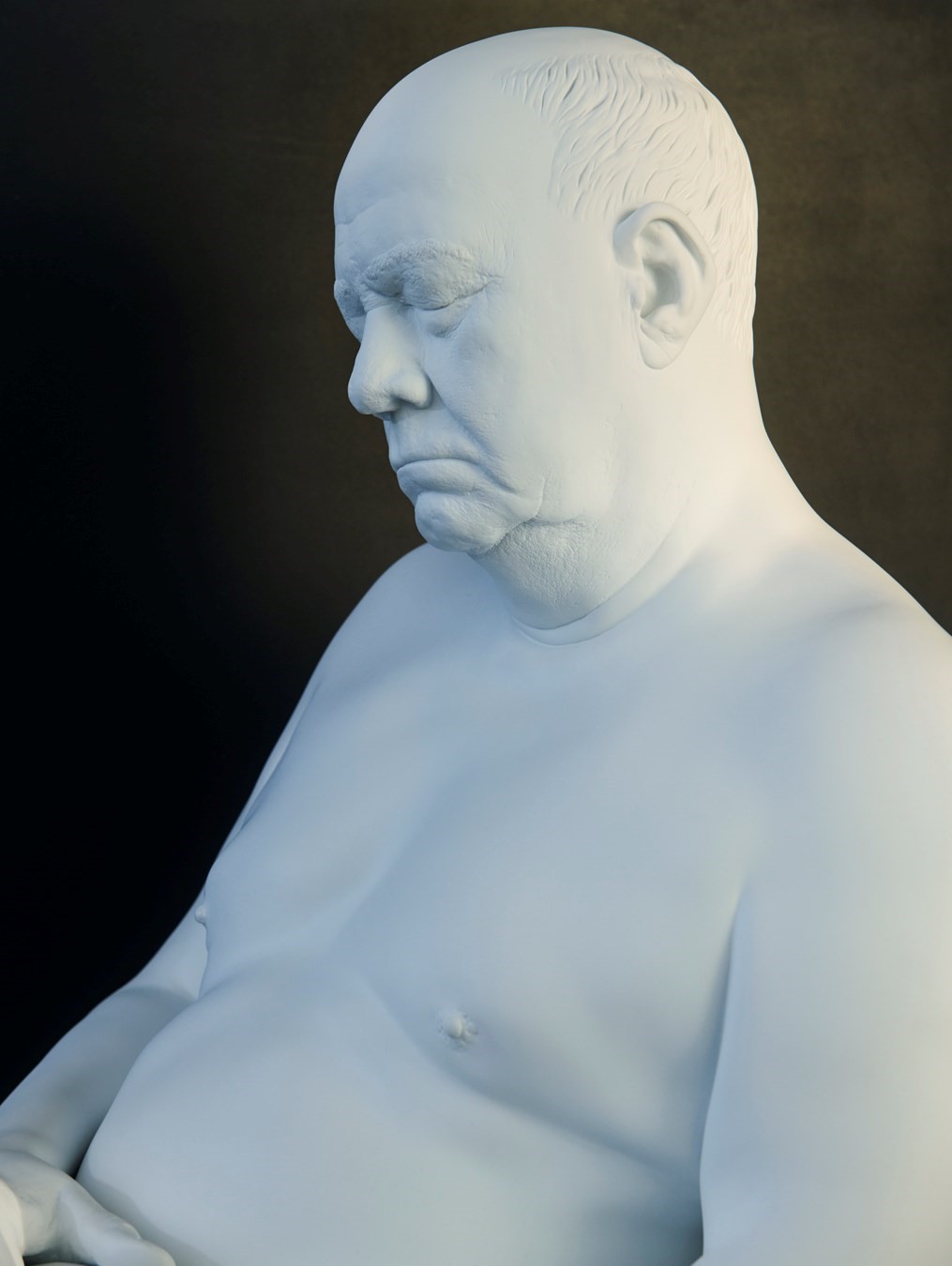
HUO: In this show the viewer will be immersed in different environments at Fondazione Prada, while passing through different aesthetic universes, starting at the Podium [building]. Whenever we talk about Fondazione Prada, we should always keep in mind that it is not exclusively a place for contemporary art, but as the late Alexander Dorner, the great museum director in the earlier part of the 20th century said, “If we want to understand the forces that are effective in visual arts, we can only do that if we understand what’s happening in other disciplines: in poetry, in music, in literature, in science, in fashion, in architecture.” And I think that’s very relevant at Fondazione Prada. There is also philosophy involved, poetry, architecture and science in Venice during the Art Biennale.
It’s transdisciplinary but also transhistorical. The future is often invented with fragrance from the past. And that happened in a very early show at Fondazione Prada – Serial Classic, in 2015, curated by Salvatore Settis and Anna Anguissola. Rem Koolhaas, the architect of Fondazione Prada, was involved in the exhibition design – which brought together the contemporary spirit of the organisation with historic sculptures. You’re revisiting that idea, inspired by that initial show – we will encounter your work alongside some very old works.
ME: Yes. Classical and neoclassical sculptures depicting the male figure in various situations. A few of the sculptures that were in Serial Classic will also be reintroduced in our display. We were thinking about how not to forget things so fast. The show was not that long ago, but it’s long enough ago for many people to have forgotten it. It’s our dedication to that brilliant display and the inauguration of the space itself.
ID: Which is what you often talk about, Hans Ulrich, this art-world amnesia. It’s so prevalent – things are over very quickly.
ME: What we wanted to do was to take this beautiful design concept and transform it in our own way, using a display that could remind people of the first showcase of Fondazione Prada, and somehow reinterpret that with added meaning from our perspective.
ID: The decision was also influenced by the fact that we have been working a lot with figurative sculpture, especially dealing with the male body and different ideas of masculinity. We felt that it would fit to present some of our sculptures together with these sculptures from history to create a different kind of narrative. Also to look at the past with a contemporary notion of masculinity. We have very consciously chosen sculptures that are not representative of this heroic ideal of the male body, but represent something softer, like a cleaning ritual or caretaking.
ME: There’s a sort of false perception of classical and neoclassical sculptures all being heroic and driven by a macho masculinity. Only a minor part of classical and neoclassical sculptures actually manifests that. So instead of making a juxtaposition, or a confrontation, with warlords and muscular athletes on one side and our contemporary depictions of masculinity on the other, we found there was a rich source of sculptures to choose from that would bridge the gap in time. Many historic sculptures portray an image of masculinity that’s completely unlike what art history from the 19th century has wanted us to believe classical sculpture was about. There are Greek and Roman sculptures that show ordinary citizens and there are a lot of neoclassical sculptures that have less of a stereotypically gendered appearance.
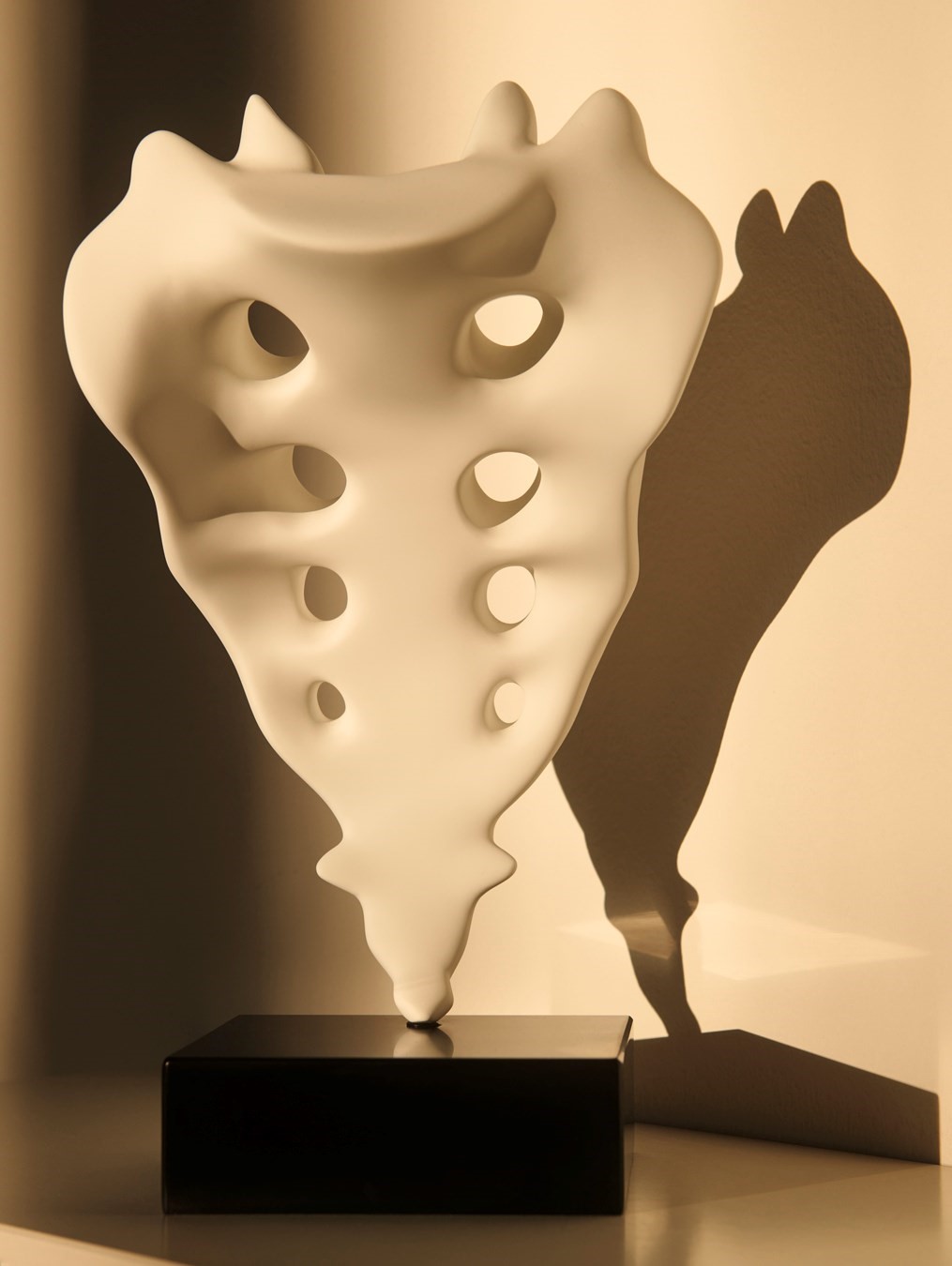

HUO: You’ve just reminded me of the many times I passed Powerless Structures, Fig. 101 [2012] – the bronze statue of a little boy on a rocking horse on the Fourth Plinth in Trafalgar Square – which in a similar way talked about differences in masculinity in a context where we are used to this masculine monumentality. Will that work be there?
ME: No, that work is not included, but it could have been. There will be 15 figurative sculptures by us and ten historical works.
ID: From our side there will also be male figures engaging in close to imperceptible kinds of activity, almost stuck to the point of doing absolutely nothing. Like Bogdan [2020], an older man in a wheelchair sleeping, or The Observer (Umbro) [2021] – a man standing on the balcony, just looking out, cigarette in hand, which is a very typical scene that we see here from the windows of our studio in Berlin. This inactivity can also be very beautiful and contemplative somehow, it can inspire you in a different way.
HUO: From there one goes to the second floor of the Podium, and there is a transformation.
ID: Yes. The whole space upstairs is full of empty workstations, which we had actually thought up two years before the pandemic, before people really did have to leave their offices. We were really debating – between ourselves and also with the team at the foundation – “Is it still worth showing? Will people think that this is all about the pandemic?” Still, the installation deals with a process that had already started before the pandemic – it has just been emphasised over the past two years. We were already using our homes and screens much more than before. The actual social element of work – being in a community, being part of a team – has constantly decreased over the past few decades. It is still important for us to show this piece and open the debate further than just talking about the Covid-19 pandemic.
ME: Due to the pandemic the installation has almost turned into a memorial to the communal work situation of former times. But when you see how harsh this work environment is, the question is also ...
ID: Should we go back?
ME: Yes, is it really such a loss?
ID: This is how we’ve been working for many years. Also, if you look back at The Welfare Show that we did at the Serpentine Galleries in early 2006, it was looking critically at the decline of the welfare state as we know it – in terms of the Scandinavian model, or even the British model, that had developed post-second world war. It wasn’t exactly a romanticised version of the welfare state we were showing either – it talked about how many elements of the welfare-state thinking from the mid-20th century are also problematic, in terms of the way we are controlled, the way we’re all expected to be the same, this sort of monocultural idea that’s embedded in the whole physical architecture of the welfare state.
ME: At the Serpentine Galleries, for instance, we had this whole room filled with gallery guards who had nothing to guard, but whose presence was very strong. And there was another room that looked like a talk show studio that visitors could not enter but just look into, through a window. So there was the notion of overcrowded rooms and rooms with absolutely no one in – a notion of regulation and of exclusion. In the exhibition Useless Bodies? we return to these subjects.
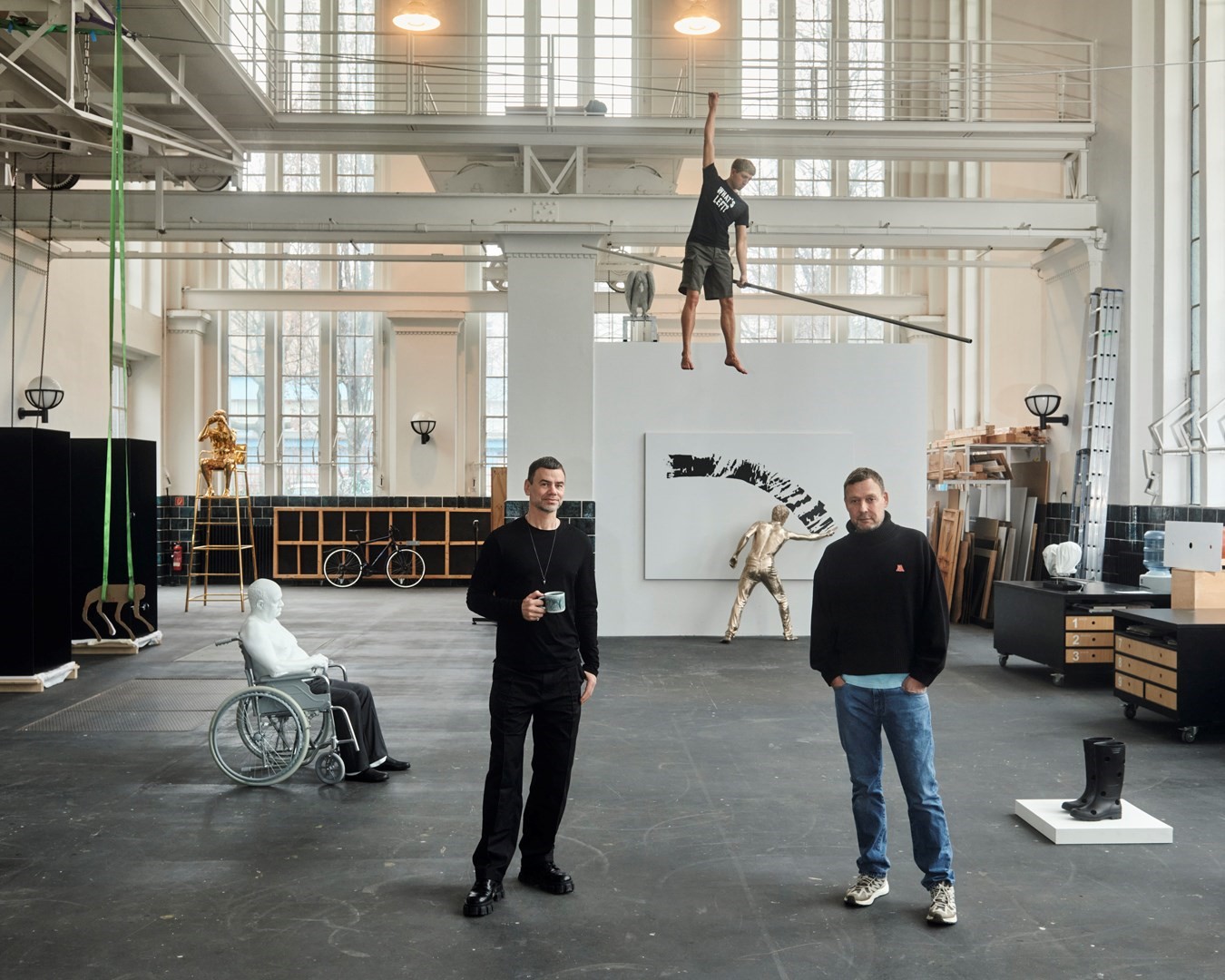
HUO: We begin the conversation about the past, then we come to the present or we could even say, as we call it in the book I wrote with Shumon Basar and Douglas Coupland, the extreme present. This place of work has a lot to do with the extreme present. And then the journey continues, somehow, to the future. Next, in the Nord gallery, there is a futuristic kind of domestic situation – you start thinking about the new domestic landscape. It’s again dehumanised, you are not present. There is also a robotic appearance. What about the future? I mean, as [the artist] Martha Rosler says, “The future always flies in under the radar.”
ID: That’s a good quote.
ME: It would be terrible if one could predict the future. We have experienced a radical shift in the notion of home in the past ten years. Home has a different function today – because of our screens. Our homes have been reduced to the backdrop for Zoom meetings instead of the frame for dinner parties. We sit here in Berlin, you sit in Zurich, in each of our units instead of being together in the same room as we were many years ago with our first interview. Our home in the Nord gallery has quite a hostile interior of extreme vanity. It’s not a room where you can rest – we’ve designed the furniture so that everything is slightly uncomfortable. It’s also not possible to perform activities here. Embedded into one of the metal-clad walls is a huge LED screen that shows Il Quarto Stato [1898-1902] by Giuseppe Pellizza da Volpedo, the first famous painting depicting a workers’ strike. On top of it is an endless stream of notifications – heartbeats and health information, likes on social media and so on. The social media ranking and the tracing of personal data are the exact opposite of a workers’ strike. Whereas the strike is about solidarity and physical manifestation in a bodily way, the stream of personal data across the screen is a symptom of something highly narcissistic.
“I think about all the health and safety regulations in our big cities, how regulators look at our use of public space as a problem that needs to be solved rather than a celebration of togetherness. Now the body is even a symbol of threat because we can transmit illnesses to each other just by our proximity” – Michael Elmgreen
ID: There is a sort of kitchen, a dining area, a bedroom-ish area, a lounge, but every piece of furniture is more like a sculpture, in a way. It’s not furniture that you feel very invited to use. The kitchen is more like a Donald Judd sculpture and is very much inspired by Judd’s sculptures from our numerous trips to Marfa and The Chinati Foundation. And the bed is this never-successful designer Danish daybed, called The Wave. It’s a combination of found objects as usual – we don’t make hierarchies necessarily between existing architecture, created architecture, other people’s design or artwork, or our own artworks or designs. All together it becomes like one big expression. It’s a very large home – a very vain space. At the same time, this home becomes a symbol of extreme isolation, an isolation that you’re not really even fully aware of, which I think is something many of us can recognise in our own lives.
ME: Every time we have worked on a domestic setting, be it at the Victoria and Albert Museum or as part of the Nordic and Danish pavilions at the Venice Biennale, we have only designed the furniture ourselves if we couldn’t source the right ready-made object. If it already exists, there’s no reason to make our own.
ID: Maybe it’s also worth mentioning a little detail – or not so little – at the end of this domestic setting, which is like a memento mori. It’s a morgue. There’s literally the body of a man sticking out of a metal compartment on the end wall, ironically at the opposite end of the fridge in the kitchen area.
ME: That’s the only human presence in the Nord gallery. The great thing about Fondazione Prada is that the spaces are so different. It’s such a good concept for an art institution to have multiple venues that have very different characteristics. So it’s possible to create multiple universes. Whenever we do a show, we relate to the architecture or go against it – in a way, the spatial setting is really important for our decisions.
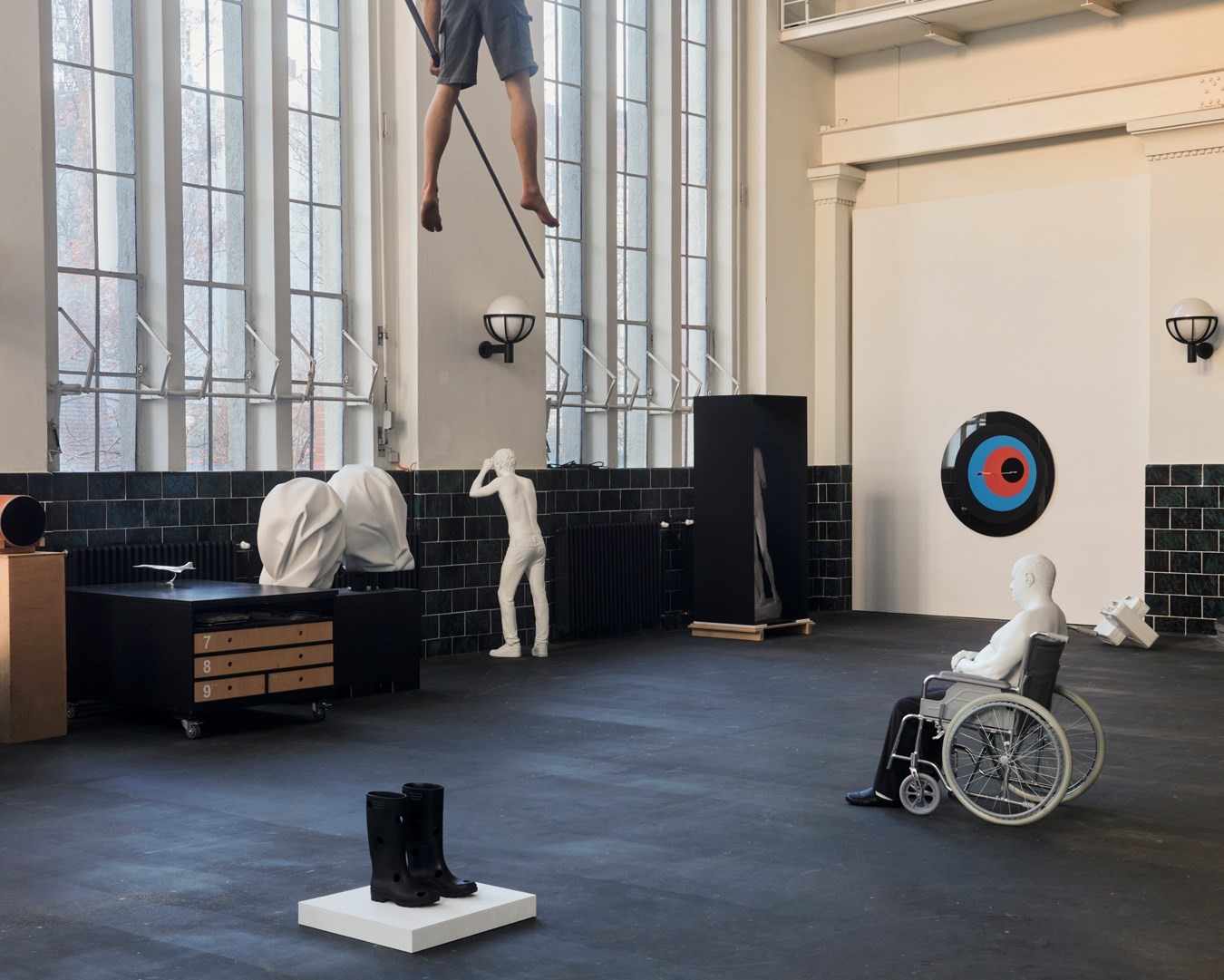
HUO: It’s great you said that – it’s really important that not only are the spaces diverse, but also that there are some smaller ones and some bigger ones. Viewers will experience these very immersive environments in these diverse spaces from the past. There’s a quote by William Faulkner – “The past is never dead. It’s not even past.” You’re not in the past, but you’re constantly in dialogue with it. Then there is the extreme present, the workstation, where “the future always flies in under the radar”. And then we come to the Cisterna, and the journey continues. In the Cisterna, you go into the theme of leisure and health. It’s a spa-like space, where, I suppose, the boundaries between work and leisure are very fluid. What’s going to happen in your spa?
ME: The spa is an old-school spa. It’s a mix of a spa and a gymnasium, like a place where you would train your body in the hope of optimising your physical self. The more our bodies have been marginalised over time, the more offers we have received from well-being industries. It’s a crazy, trillion-dollar industry that will try to persuade us to spend our money on diets, plastic surgery – all kinds of bodily improvements – so we can regain our self-worth. Now that our body is of no use in the work situation and our bodies are taking up space, the message is that we should at least make them aesthetical objects – and we should live longer by using these facilities.
ID: We have built an abandoned pool because we love abandoned pools – we are very romantic about them because we think they speak so much about a past with different dreams and different values. We also have a tightrope walker who has fallen down from the wire and is now hanging on to it with just one arm, holding his balancing pole with the other one [What’s Left? (2021)]. He wears a T-shirt that says “What’s left?”. We don’t know if he will make it up on that wire again or if he will fall down on our heads.
ME: And then you have a realistic-looking male body lying on a massage bench in a changing room where our shyness, or vulnerability, comes to the fore – a place where you expose yourself. The poor guy on the massage bench will probably never receive his treatment – he might lie there waiting for ever. The spa is also interesting in relation to us as art viewers because we have this voyeurism. When we go to exhibitions we are allowed to look not only at the art but also at each other. If we were to stare like that in the subway or in many other situations, we would be asking for trouble. In the art exhibition, you are allowed to be a voyeur, you can temporarily get rid of your shyness.
HUO: Yes, that’s a great answer, and I think it covers everything in relation to these different spaces. Lina Bo Bardi said of her glass house in São Paulo, “The insides are on the outside,” and there is an important outside component in this exhibition – you are using the outdoor spaces. As often in your work you show very unexpected perspectives of quotidian things. We spoke about the Rockefeller piece and how, all of a sudden, a very familiar object can appear very different when seen from a new angle – how, when you turn something around, you turn it into something else, you remove the function of these objects. Can you tell us about the outdoor sculptures?
ID: Sure, but it’s funny because we often quote and talk about Lina Bo Bardi. She inspired us very early on when we visited SESC Pompéia in São Paulo, one of her signature buildings, where there’s a fireplace inside this very open but communal space. And this created such a special atmosphere within this huge concrete brutalist space that she created and gave everybody – from street kids to the more intellectual, culturally minded visitors – this feeling of entering a home, even though it’s an enormous space. Since then, whenever we have dealt with domestic settings, we have always included a fireplace, whether it was in Venice, in the Nordic pavilion, at ZKM in Karlsruhe, or at the V&A in London.
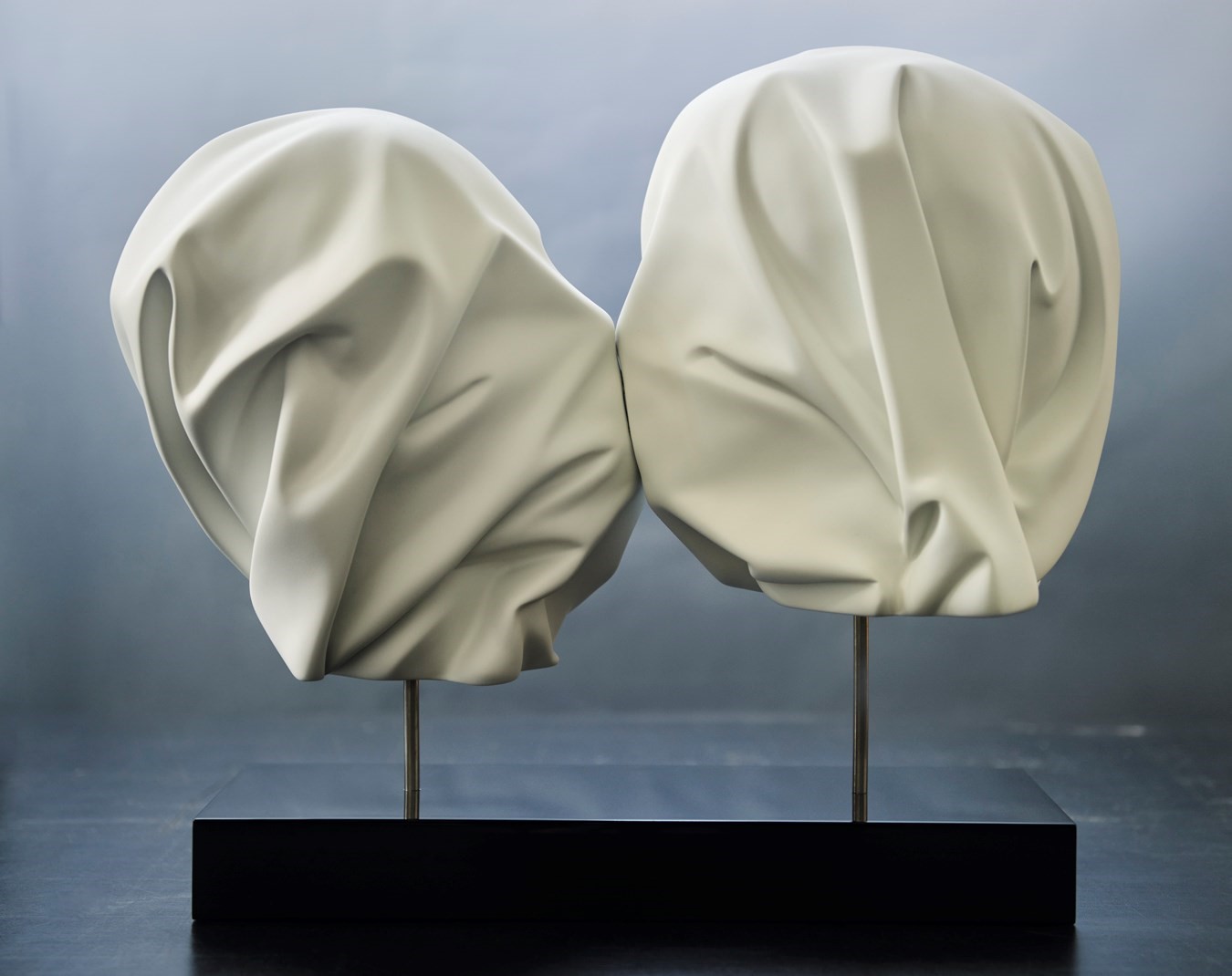
ME: For our very first exhibition in New York, Powerless Structures, Fig. 57–60 [1998], at The Project, up in Harlem, we did a communal fireplace in part of the gallery that people could use from a parallel street. So Lina Bo Bardi’s fireplace was a real trigger for our idea of how, actually, a home can be everywhere. Even in a public institution.
ID: Even with doors wide open, semi-inside, semi-outside. Of course we also have a fireplace in the Nord gallery at Fondazione Prada. But moving back outside, there’ll be a car, very oddly parked just at the bottom of the Torre. This will be the big Mercedes estate car that we showed once before, at Unlimited at Art Basel last year, with two art installers seemingly sleeping in the boot.
HUO: Can you describe the piece for the readers?
ID: These guys are spooning in the boot of this white Mercedes that has Russian number plates. As we know, there are many people crossing borders for work and temporary work. Especially for Art Basel, there are people coming from Germany, from Latvia, from Poland and Russia, to work for good money for a week or two, but they’re never invited inside really, to all the VIP events, or whatever is going on once things have been installed. So this is also a comment on hierarchies between different people within the art world.
ME: It’s a tribute to some of the people who actually make these exhibitions happen for us. Without them, we would be nothing.
ID: The way the body is controlled in public space is something that we have talked about often in our work. At Fondazione Prada we have placed street signs around the compound – a series of sculptures that we call Adaptations [2018–20]. They’re without any instructions, or signs, but the only thing that makes them recognisable to viewers is their shape. They are completely reflective and they basically adapt to the surroundings, so they don’t give you any particular instructions on where to go or how to behave, which is how we normally read those signs and then move accordingly.
ME: The interesting thing with street markings and traffic signs in our urban spaces is that it’s actually the only global language – it is more or less the same no matter where you travel – no matter where you go in the world, you have the same signs. And you have the same divisions with white stripes on the streets. It’s something we might not think about, but if we came from the 17th century, I think we would be extremely shocked about how regulated we are in our urban settings today if we were to look at how we follow all the markings in our streets and wait for the green light, or how we navigate urban space. We have reached an extreme degree of control, which is, of course, something we need to agree upon to make our society function. But at the same time it’s also quite amazing to think that we are willing to be that controlled.
HUO: I am so grateful for this interview. And I really hope we can meet in real life again – I look forward to seeing you.
This article appears in the Spring/Summer 2022 issue of AnOther Magazine, which is on sale here.
Useless Bodies? by Elmgreen & Dragset is on at Fondazione Prada until August 22.

